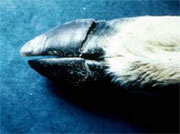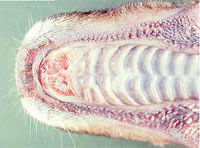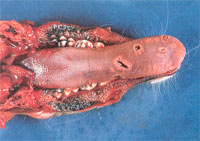Diseases and Parasites of Maryland Deer
Main_Content
Hemorrhagic Disease (HD)
|
|
Biting midges (“no see ums”) transmit this viral disease of white-tailed deer. Deer die from extensive internal hemorrhages. HD typically appears during the late summer or early fall. The appearance of sick or dead deer near water at this time of year is an indication of potential HD.
Early signs of infection are respiratory distress, swelling of the head, neck or tongue and stupor. Deer may have open sores on the tongue and upper front dental pad. Deer that survive the initial infection may have reduced mobility related to lameness. Some of these deer may not live. Surviving deer show hooves with sloughing tissue.
DNR monitors HD by looking for sloughing hoof tissue on deer harvested during firearm deer hunting season. HD appears annually in Maryland with varying distribution and intensity. Typical white-tailed deer mortality rates are less than 25 percent and do not occur over large landscapes.
The virus is not contagious to humans and only harvested deer with huge open sores should not be consumed. Dogs, cats and sheep are not affected, but cattle can exhibit very mild symptoms.
A hemorrhagic disease Q & A sheet with additional information is available on the DNR Website.
|

Photograph of sloughing hoof tissue sloughing hoof tissue
|
|

Photograph of ulcerated upper dental pad ulcerated upper dental pad
|
|

Photograph showing ulcerated tongue of white-tailed deer ulcerated tongue
|